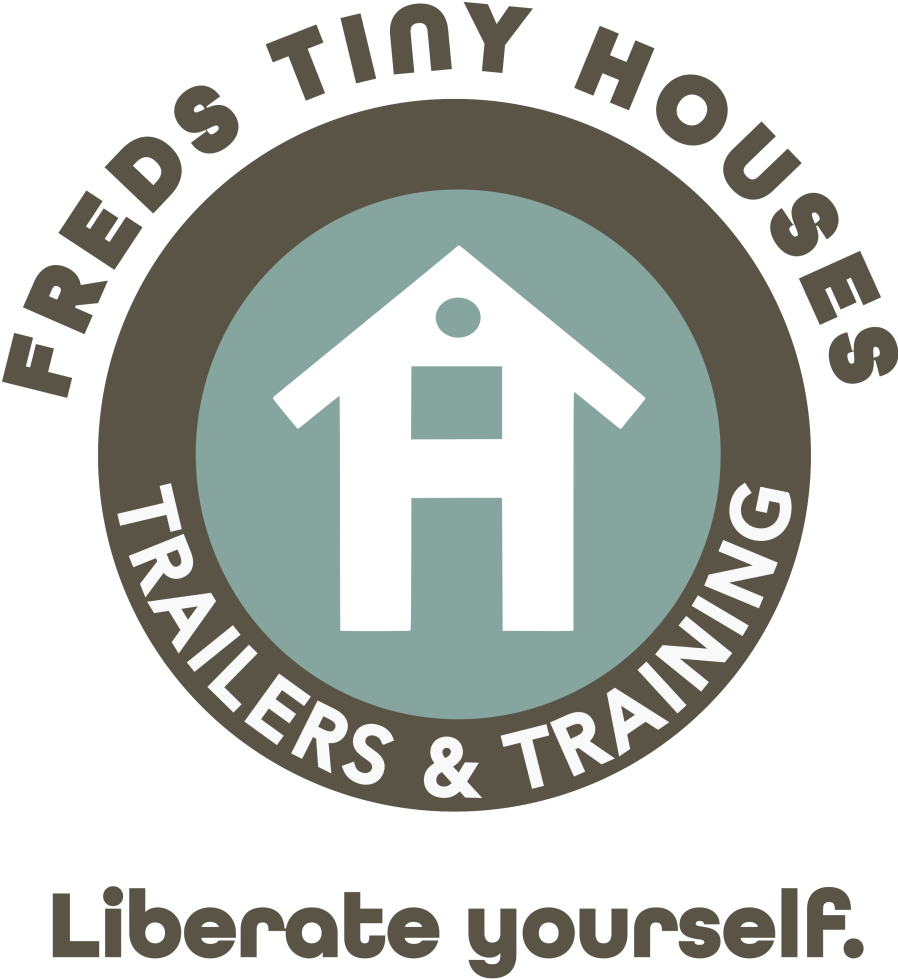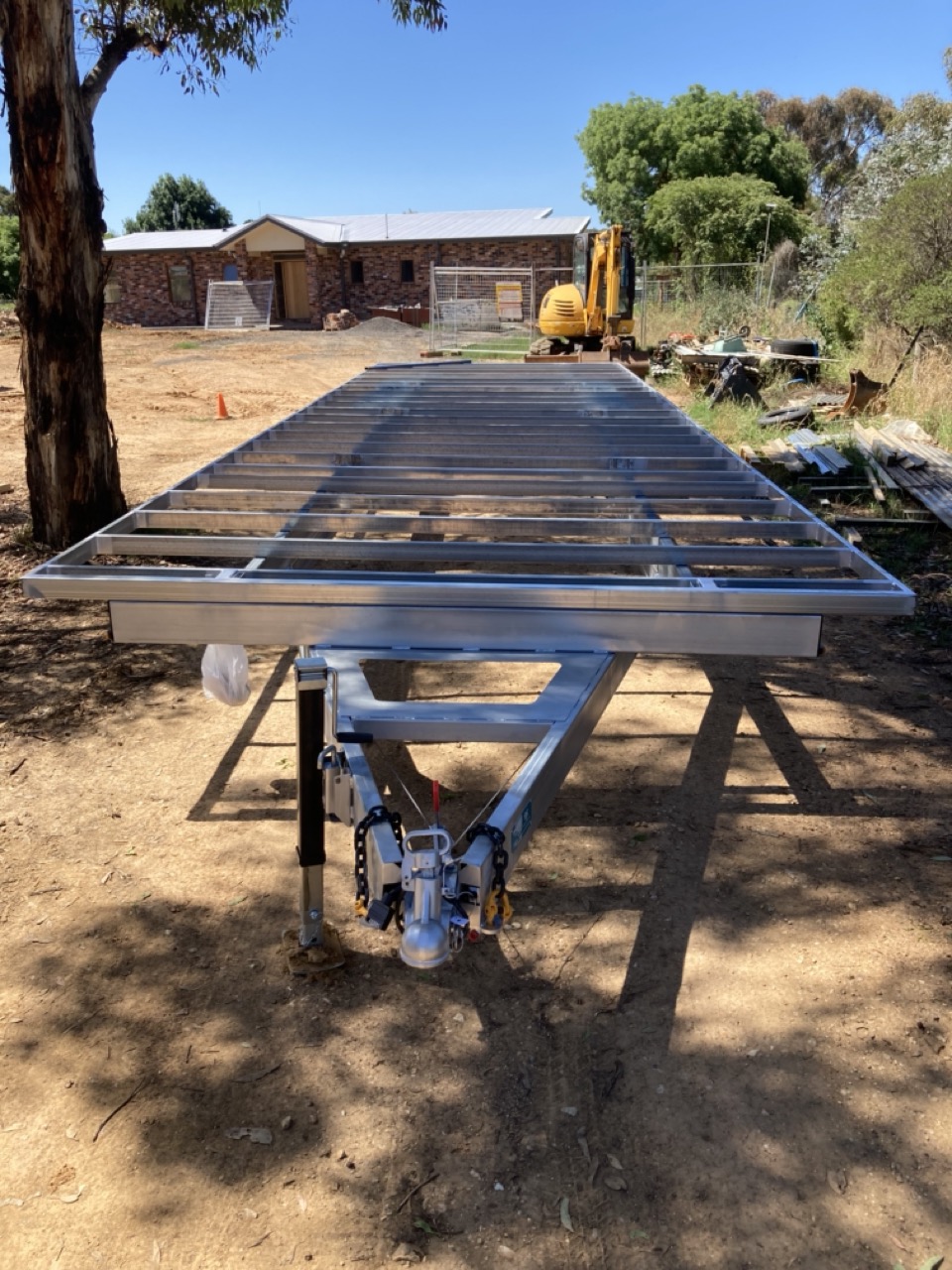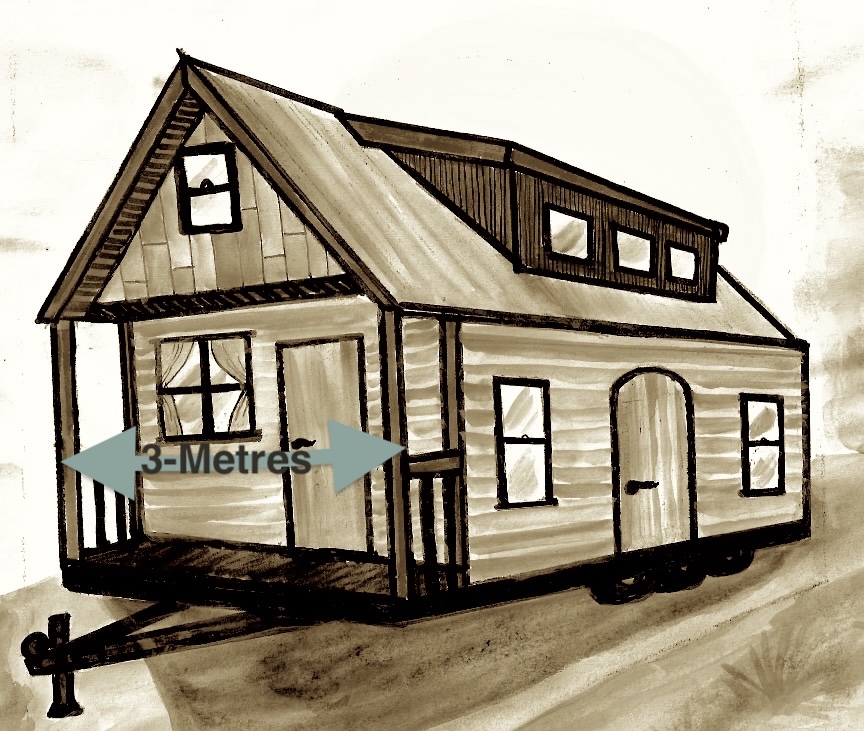
BUYER BEWARE
Many tiny house builders in Australia advertise 3-metre-wide (or greater) tiny houses as if they are fully road-compliant when they are not. Many use ambiguous language to imply compliance by stating that the tiny house is built on a registered trailer—this is deceptive. Some even claim or imply that it’s registrable as a caravan—this is false.
In addition to all this, many sellers do not clearly explain the implications of choosing a 3-metre wide tiny house load, including:
- Insurance: The risk of not being able to access insurance products.
- Council: The grey area surrounding local council classification, and
- Registration of Trailer: The trailer registration will be voided if the tiny house load is attached incorrectly.
To be well informed before you build or buy a 3-metre wide tiny house load, you need to understand:
1.) the rules for registered trailers, and
2.) securing oversized loads.
While a 3-metre wide might suit your housing needs, buying something that is non-compliant can have serious and costly outcomes, so don’t let yourself be deceived by a sales person.
Read this document to become fully informed.
We at Fred’s Tiny Houses have consulted extensively with vehicle engineers and federal officials governed by the relevant vehicle safety legislation, and this document shares the key insights we’ve gained.
Australian Transport Rules Explained (with references).
Carrying a load on an unregistered trailer is not permitted:
Load restraint rules:
Once a vehicle is registered and carrying a load, state laws apply. Differences between states often stem from referencing different editions of the same Load Restraint Guide by the National Transport Commission. 6,7
FALSE CLAIM:
“It’s a caravan, like every other Tiny House on Wheels.”
THE REALITY:
3-Metre wide tiny houses on wheels must be configured as a removable load on a registered trailer.
By exceeding the allowable 2.5 meter width limitation of registrable vehicles, the 3-metre wide tiny house is over-dimensioned and CANNOT BE REGISTERED as a caravan. 8,9
The method of securing a 3-metre wide load to a registered trailer really does matter:
Bolting a 3-Meter Wide Tiny House Load on to a trailer is a permanent modification and voids the registration of the trailer.
Permanent or temporary? If you need a tool to remove the load then it is considered a permanent modification. Bolting or welding the 3-metre wide tiny house load is a permanent modification to the trailer10 and therefore voids the registration of the trailer.
Over-dimensioned vehicle permits are available in every state and territory for carrying an over sized load, including 3-metre wide tiny house loads.
Fred’s Tiny Houses 3-Meter Wide Extension Bases are compliant as a temporary load on a trailer.
Fred’s Tiny Houses uses an engineer-approved, detachable clip-down system that is genuinely temporary and keeps your trailer legally registered while carrying a 3-metre wide tiny house load—up to 4500kg (including trailer). (Scroll down for product links).
Council Implications Explained.
Registered Vehicle or Not?
The way that councils will classify tiny houses on wheels that are registered caravans (THOW) may be different to how they classify tiny houses that are over-dimensioned and therefore not able to be registered.
Council Inspections:
Council staff are obliged to inspect a property when they receive a complaint about illegal building works or if someone is thought to be violating local laws regarding ‘camping on private property’—such as occupying a tiny house on wheels beyond the allowed time frame.14
Will my 3-metre wide tiny house load be classified as a vehicle or a building?
During an inspection, council staff will have to decide how they classify an over-dimensioned tiny house load. It is their role to determine what it is, because they determine something called the use of land.
Upon inspection, the council representative may classify an over-dimensioned tiny house load as a temporary building or secondary dwelling, because it does not meet vehicle standards. In which case, building permits, development applications and the planning scheme may be considered applicable to the 3-metre wide tiny house load.
Alternatively, the council representative may consider the 3-metre wide tiny house load on a trailer to be ‘caravan enough’ and therefore apply the relevant local laws around camping on private property.
Grey Area
Since a 3-metre wide tiny house load is neither a vehicle, nor an NCC compliant building, the council classification may end up being a subjective choice by the individual council representative. Consequently, a 3-metre wide tiny house load exists in a grey area, and whether it is a viable option for you depends on your personal tolerance for risk of running afoul of council.
Removed the wheels?
There will also be different regulatory requirements if the tiny house is not on wheels, or removed from the trailer, as it would then likely be legally defined as a building and all permits and regulations pertaining to buildings – including planning and development requirements – would apply. (See FAQs below for more.)
Be cautious of false equivalences made by the sellers who claim council laws allowing habitation in a caravan will apply to a 3-metre wide tiny house load on a trailer. This is a dubious equivalency that requires further investigation.
Insurance Implications Explained.
Insuring your tiny house:
At the time of publication (April 2025) there is one insurance company with an insurance product available in Australia explicitly for THOW. That company is CIL. The tiny house insurance product that they offer is only available for THOW that follow the standard caravan dimensions as laid out in the Vehicle Standards Bulletin 1 (Revision 6) 15. This means that in order for the tiny house on wheels to qualify for insurance cover, it needs to be:
- Maximum width: 2.5m
- Maximum height: 4.3m from ground.
- Maximum length 12.5m.
- If a tiny house on wheels is over the weight rating of the trailer, it is un-roadworthy and will not qualify for insurance.
- If the tiny house is built on a trailer rated to more than 4500kgs, it will not be eligible for insurance from CIL. 16
A 3-metre wide tiny house load is not eligible for standard caravan insurance policies.
Insurance companies will take your money…
An insurer will take your money to insure your THOW, but if it turns out that your THOW was not compliant in some way, they may use that as a reason to avoid paying out when you make a claim.
FAQs
Q: “The 3-metre wide tiny house load is designed to be removable, so I can take it off the trailer once it’s onsite, right?”
A: Although the road rules require the house to be removable, FTH trailer 3-metre wide trailer base extension is not designed to be lifted off the trailer frequently. The trailer is considered the foundation of the extension base, and is an essential part of the engineering approval of the extension base as a compliant load.
If you choose to remove the tiny house from the trailer, consider the following:
- You will need a safe way to lift and stabilise the house on footings.
- Once off the trailer, the house is no longer governed by vehicle regulations but by building regulations.
- This means you may need:
- A building permit;
- Compliance with the National Construction Code (NCC);
- Development applications and planning approvals and
- Consideration of local council overlays.
How To Legally Transport 3-Metre Wide Tiny House Loads.
Engineered solutions for safe transport
At Fred’s Tiny Houses we provide:
– Engineered 3-meter-wide extension bases for our flat-top trailers.
– Safe fastening methods that comply with road rules.
– Load-bearing solutions designed specifically for our trailers.
3-Meter Wide Extension Bases Available in 4 Trailer Lengths
Our 3-Meter Wide Tiny House Extension Bases are designed to connect to a limited range of our Flat Top Tiny House Trailers.
3-Metre Extension Bases:
Compatible Flat Top Trailers:
-

6 Meter Flat Top Tiny House Trailer DuraGal 2.4m Wide 4500kg rated (#5 DG)
$11,990.00 -

6 Meter Flat Top Tiny House Trailer Hot Dip Galvanized 2.4m Wide 4500kg rated (#5 HDG)
$14,685.00 -
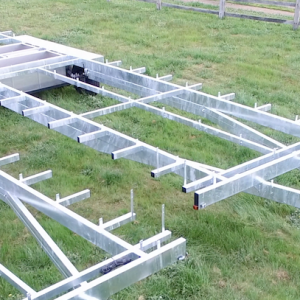
9 Meter Flat Top Trailer Hot Dip Galvanized Triaxle 2.4m Wide 4500kg rated (#12 HDG)
$17,600.00 -
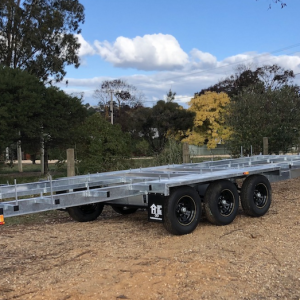
7.2 Meter Flat Top Trailer Hot Dip Galvanized Triaxle 2.4m Wide 4500kg rated (#7 HDG)
$16,215.00 -
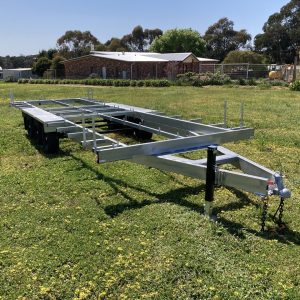
7.2 Meter Flat Top Trailer DuraGal Triaxle 2.4m Wide 4500kg rated (#7 DG)
$13,250.00 -

8 Meter Flat Top Trailer DuraGal Triaxle 2.4m Wide 4500kg rated (#11 DG)
$13,670.00 -

8 Meter Flat Top Trailer Hot Dip Galvanized Triaxle 2.4m Wide 4500kg rated (#11 HDG)
$16,860.00 -

9 Meter Flat Top Trailer DuraGal Triaxle 2.4m Wide 4500kg rated (#12 DG)
$14,125.00
Reference Notes
1 Unregistered Vehicle Permits (UVP), Transport Victoria, ”You can’t tow or carry a load on any other unregistered trailer if it has been issued with a UVP.”, accessed April 11, 2025, https://transport.vic.gov.au/Road-rules-and-safety/Permits/Unregistered-vehicle-permits.
2 Unregistered Vehicle Permit (UVP), Government of South Australia, “Permits are not available for vehicles being used for hire, reward, to carry a load or for commercial purposes”, accessed April 11, 2025, https://www.sa.gov.au/topics/driving-and-transport/registration/conditional-registration/unregistered-vehicle-permits.
3 Application for Unregistered Vehicle Permit, Transport NSW, “Vehicles carrying a commercial load, exempt from registration, or written-off cannot be issued with a UVP”, accessed April 11, 2025, https://tfnswforms.transport.nsw.gov.au/45070190-unregistered-vehicle-permit.pdf.
4 Get A Temporary Movement Permit, Government of Western Australia Department of Transportation, ”A vehicle subject to a temporary movement permit should not carry a load on a road unless the goods are the property of the owner of the vehicle and are not for sale or disposal. For example, goods that can be carried include boats on trailers and goods carried in caravans, display vehicles, etc.” accessed April 11, 2025, https://www.transport.wa.gov.au/licensing/get-a-temporary-movement-permit.asp.
5 Unregistered Vehicle Permit (UVP), Queensland Government, “When a permit cannot be issued. You won’t be able to get a permit if your vehicle: …is carrying a load for hire or reward, or is an unregistered trailer taking rubbish to the dump”, accessed April 11, 2025, https://www.qld.gov.au/transport/buying/unregistered/uvp.
6 Load Restraint Guide, National Transport Commission, (Canberra: National Transport Commission, 2018), accessed April 11, 2025, https://www.ntc.gov.au/codes-and-guidelines/load-restraint-guide.
7 Load Restraint Guide (2023 Edition), Coates, accessed April 11, 2025, https://www.coates.com.au/-/media/files/coates-load-restraint-guide-2023.pdf.
8 Vehicle Standards Bulletin 1 – Trailers with an aggregate trailer mass of 4.5 tonnes or less, Revision 6 (September 2024), Section 5.2, “Maximum Width – 2,500mm”, page 18. https://www.infrastructure.gov.au/sites/default/files/documents/vsb1-revision-6-trailers-with-an-aggregate-trailer-mass-of-4.5-tonnes-or-less-september2024.pdf.
9 Vehicle Standard (Australian Design Rule 43/04 – Vehicle Configuration and Dimensions) 2006, Australian Government, Federal Register of Legislation, accessed April 11, 2025, https://www.legislation.gov.au/F2006L01430/latest/text.
10 Anton Pretorius (Vehicle Standards Officer • Vehicle Standards Section/Vehicle Safety Policy & P/ships • Road and Vehicle, Safety Division, Department of Infrastructure, Transport, Regional Development, Communications and the Arts), email message to author April 4, 2025.
11 Modifying Trailers in NSW, NSW Government, “If a trailer is modified outside of instructions issued by a manufacturer, the trailer will require certification by a Vehicle Safety Compliance Certification Scheme (VSCCS) Licensed Certifier.” accessed April 11, 2025, https://www.nsw.gov.au/driving-boating-and-transport/vehicle-registration/how-to-register/modifying-trailers-nsw.
12 LS12 Light Trailer Modifications, Queensland Government Department of Transport and Main Roads, September 2021 ,”Modifications not permitted under Code LS12
Modifications that must not be certified under LS12 code are: Changes resulting in a trailer that does not comply with VSB-1”, accessed April 11, 2025, https://www.publications.qld.gov.au/ckan-publications-attachments-prod/resources/18351544-028e-4092-9a0c-1475fef15193/ls12-light-trailer-modifications-sep-21.pdf.
13 Road Vehicle Standards Act 2018, SECT 26 Modification of road vehicle on RAV (2)(f), Commonwealth Consolidated Acts, “Modification of road vehicle on RAV, (2) A person contravenes this subsection if: (f) the modification causes the road vehicle to not satisfy the requirements of the entry pathway that applied at the time the vehicle was entered on the RAV”, accessed April 11, 2025, https://www.austlii.edu.au/cgi-bin/viewdoc/au/legis/cth/consol_act/rvsa2018203/s26.html.
14 Candid Tiny House, Season 2, Episode 4, “Inside Local Government: How Mount Alexander Shire Legalised Tiny Houses,” Apple Podcasts, 15:15, https://podcasts.apple.com/au/podcast/inside-local-government-how-mount-alexander-shire-legalised/id1585078095?i=1000660474463.
15 Vehicle Standards Bulletin 1 – Trailers with an aggregate trailer mass of 4.5 tonnes or less, Revision 6 (September 2024), Section 4.2.1 Caravan; Section 13.2 Caravan-specific requirements, accessed April 11, 2025, https://www.infrastructure.gov.au/sites/default/files/documents/vsb1-revision-6-trailers-with-an-aggregate-trailer-mass-of-4.5-tonnes-or-less-september2024.pdf.
16 CIL Insurance representative, telephone conversation with Shannon Schultz, February 28, 2025.
